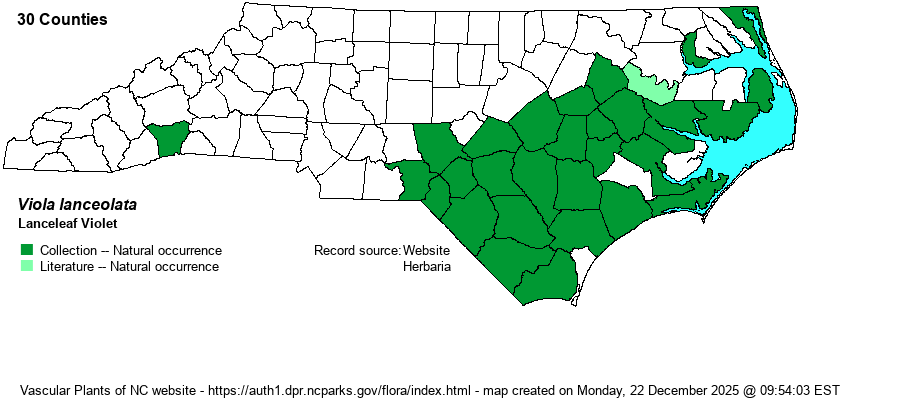| Author | L. | |
| Distribution | Nearly throughout the Coastal Plain, though scarce or absent in most northern counties. A disjunct record, probably now historical, from the southern Mountains (Henderson County).
Despite a Coastal Plain range in NC, this is a widespread Eastern species, ranging across eastern Canada to southern FL and eastern TX. It is scarce to absent, however, in much of the interior regions, including the Piedmont and Appalachians.
| |
| Abundance | Fairly common to locally common in the southern half of the Coastal Plain, but much less numerous in the northern half, and rare in most of the northern counties. Likely absent now in the Mountains. | |
| Habitat | This is a species of mostly sandy, acidic wetlands, such as wet pine savannas, streamhead seepages, swamp margins and openings, depression ponds and pools, and interdune ponds. The habitats are similar to those of the widespread V. primulifolia, though that species is more frequently found in richer-soil wetlands and muddy places, as well as in acidic ones. The very similar V. vittata grows essentially in small enclosed pools and wetlands, such as depression pools and ponds and clay-based Carolina bays. | |
| Phenology | Blooms from March to May, and fruits shortly after flowering. | |
| Identification | This is one of the few white-flowered species with acaulescent stems, with all leaves being basal. The naked flowering stalk only reaches about 4-6 inches tall, with a small white flower topping each stalk. The leaf blades are narrow, being lanceolate and about 2 inches long but only about 1/4-inch wide at most. In this species, the leaf blade is 3-6 times longer than wide, as opposed to about 1.5-2 times longer than wide in V. primulifolia, but 8-15 times longer than wide in V. vittata. In addition, the leaf base is narrowly cuneate, strongly tapering to the petiole; V. primulifolia has a truncate or widely rounded leaf base. Though the leaves of V. primulifolia can be held in a spreading or upright manner, those of V. lanceolata are usually quite erect. The species is not overly hard to find in pine-dominated wetlands, and can be locally numerous; however, you should stumble into V. primulifolia more often and in more situations/habitats. | |
| Taxonomic Comments | Weakley (2020) has split out V. vittata from this species; most references include that taxon as a variety or subsumed completely within V. lanceolata.
General note on Viola: In 2009-10 B.A. Sorrie (website map editor) went through the whole collection at NCU, annotating all specimens against those verified by experts in the genus. The range maps in RAB (1968) have been changed accordingly. More recently, Harvey Ballard and colleagues are in the process of revising all Eastern and Southeastern Viola, and have annotated all specimens at NCU in July 2024. They recognize additional species not in RAB or in previous editions of Weakley et al.; we will follow updated editions of Weakley et al. in recognizing them. Species range maps have been adjusted to account for identification changes. | |
| Other Common Name(s) | Bog White Violet | |
| State Rank | S4 | |
| Global Rank | G5 | |
| State Status | | |
| US Status | | |
| USACE-agcp | OBL link |
| USACE-emp | OBL link |

